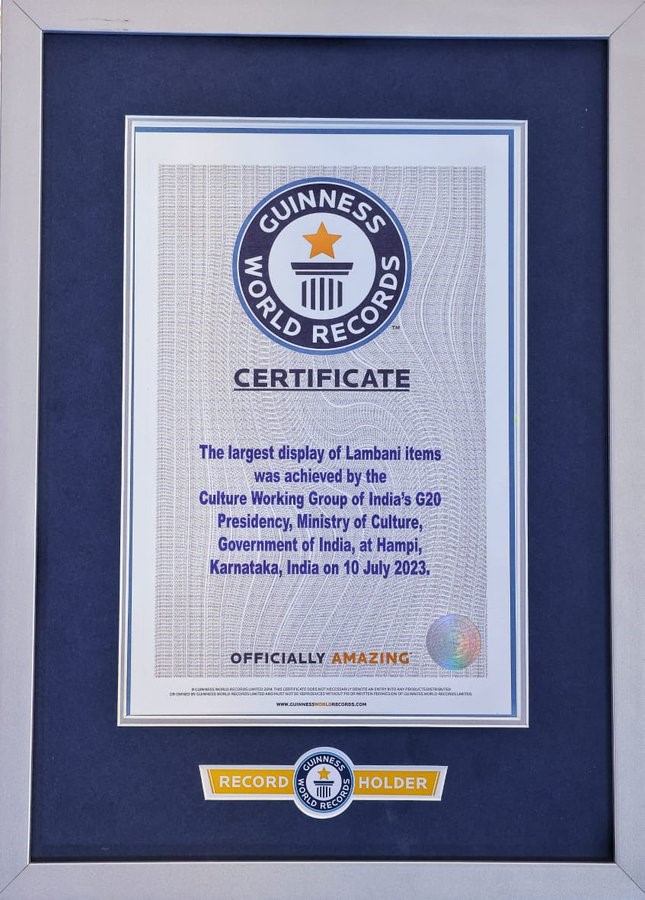Description

Disclaimer: Copyright infringement not intended.
Context
- At the 3rd G20 Culture Working Group, In Hampi, Karnataka, Guinness World Record was set for the largest display of Lambani items.
- A total of 1755 items were on display.
Other Details
- It was an effort/initiative to popularize Lambani art, craft and culture.
- This initiative is also expected to encourage the participation of Nari Shakti in such cultural activities.

Lambani Embroidery
- Also known as Banjara embroidery, it is an intricate embroidery art done on a piece of cloth.
- This art is mainly practiced by the community of Lambanis.
- This art comprises various processes such as –
- Firstly Basic tools and materials are collected – for eg – Fabric, needles, thread, accessories etc.
- Then there is selection of patterns, types and shapes of stitches, color combinations
- Accessories like beads, mirror are added in the later stage.
- Finally it is ironed to give the cloth piece a desired look.
- The final piece of cloth can be used in clothing, curtain, pillow cover, bedcovers, bags, etc.
- Sandur Lambani Embroidery is recognized with a Geographical Indication tag in 2010.
.png)
Disclaimer: Copyright infringement not intended.
Features
- Done on a loosely woven piece of cloth.
- It includes –
- Around 14 types of stitches with various geometric shapes like - squares, circles, triangles, diagonal lines etc.
- Parallel lines of multi color threads.
- Patchwork.
- Mirror work, Beads, Metal buttons, Ghungroo etc.
- Quilting.
- Applique, an ornamental needlework.
- Overlaying
- Most commonly used colors are red, yellow and blue
Who are Lambanis
- These are nomadic tribes that are spread across India.
- Regarding the origins of the Lambani community, there are many theories, some are -
- They are considered to be the descendants of the Romanis of Europe.
- Came from the Ghor province of Afghanistan and then settled in Rajasthan, Gujarat and then migrated down south.
- These tribal communities of Banjara or Lambani mainly reside in -
- Sanduru, Bellary and Bijapur in Karnataka, and
- Hyderabad in Andhra Pradesh.
Significance of Lambani Art
- Empower marginalised communities like Lambani
- Contribution to economy of the country.
- Preserve the rich cultural traditions in line with the constitutional provisions.
- It can also contribute to improving biodiversity of their region as
- Indigenous fibres are required.
- Native plant dyes are used. and
- Locally sourced materials are preferred.
- It is sustainable practice which works on the principle of recycle and reuse. No fabric or material is wasted in the process.
- Potential to enhance India’s soft power.
Efforts for Conservation
- More exhibitions to make people interested in the art.
- The artisans should be financially supported.
- There should be a formal course to learn this art.
- More promotion and brand engagement would help to revive this indigenous art.
- More efforts by government are needed to rehabilitate and reform
- GI tag will help in creating a unique selling proposition.
- More awareness about indigenous textiles and fashion will help this art to gain momentum.
Must Read Article:
GI Tag
https://www.iasgyan.in/daily-current-affairs/geographical-indication-gi-tag
https://www.iasgyan.in/daily-current-affairs/gi-tag
https://www.iasgyan.in/daily-current-affairs/geographical-indications-gi
|
PRACTICE QUESTION
Consider the following statements about Lambani Embroidery:
1. Sandur Lambani Embroidery of Karnataka was provided GI Tag in 2010.
2. This art can contribute to promoting and protecting the rich plant diversity of the region.
Which of the statements given above is/are correct?
A. 1 only
B. 2 only
C. Both 1 and 2
D. Neither 1 nor 2
Answer: (C)
|

https://pib.gov.in/PressReleasePage.aspx?PRID=1938535






.png)










